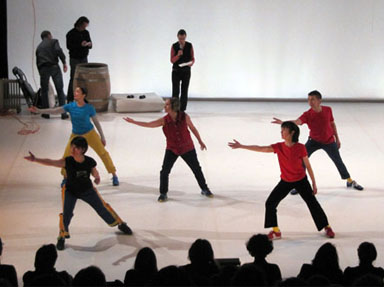
Yvonne Rainer’s ASSISTED LIVING will get its New York premiere March 16-19 at the Baryshnikov Arts Center
Baryshnikov Arts Center
450 West 37th St. between Ninth & Tenth Aves.
March 16-19, $25, 8:00
212-366-5700
www.performa-arts.org
Legendary choreographer and experimental filmmaker Yvonne Rainer looks back while moving ahead at the Baryshnikov Arts Center next week, reprising 2009’s Spiraling Down and presenting the New York premiere of Assisted Living: Good Sports 2. Drawing on principles developed in her seminal work, Trio A, and other pieces from the 1960s, Rainer’s most recent dances incorporate sports, primarily soccer, as well as old and new pop-culture references. For Assisted Living, Pat Catterson, Emily Coates, Patricia Hoffbauer, Emmanuelle Phuon, Keith Sabado, and Sally Silvers were each given photos from the New York Times sports section to inspire their movement; lighting designer Les Dickert, set designer Joel Reynolds, and Rainer herself also appear onstage, involved in set changes and various cues. The work is sponsored by Performa; since 2007, Rainer has been working with the nonprofit arts organization, which “is dedicated to exploring the critical role of live performance in the history of twentieth century art and to encouraging new directions in performance for the twenty-first century.” Rainer, who will turn seventy-seven in November, has been choreographing dances for more than fifty years, having trained with such giants as Martha Graham, Merce Cunningham, and Anna Halprin, in addition to making such influential films as The Man Who Envied Women and Privilege, earning the right to choreograph the questions in our latest, albeit brief, twi-ny talk.
twi-ny: Both works you are presenting at BAC deal with sports and sports photography, among other things. Are you a big sports fan, and what was it from those images that inspired you?
Yvonne Rainer: I am a tennis fan, but do not play myself. As a kid I loved street games, and in high school played softball. But as a choreographer it is not competitive sports that interest me so much as all the incidental movements that do not contribute directly to the rules and organization of play. For example, the languid movements of soccer players when they are waiting to be engaged and the stillness of photos that record the interactions of individual bodies.
twi-ny: How is it different performing at Judson Church back in the 1960s versus performing today in New York City?
Yvonne Rainer: At Judson Church we were a community with shared interests and enthusiasms and objectives. Today in NYC the choreographer is on her own, an autonomous molecule struggling to find a place.
twi-ny: What has it been like collaborating with Performa over the years?
Yvonne Rainer: Performa has been my life saver, a buffer in the cultural maelstrom. Their support has been essential to the continuity of my work.